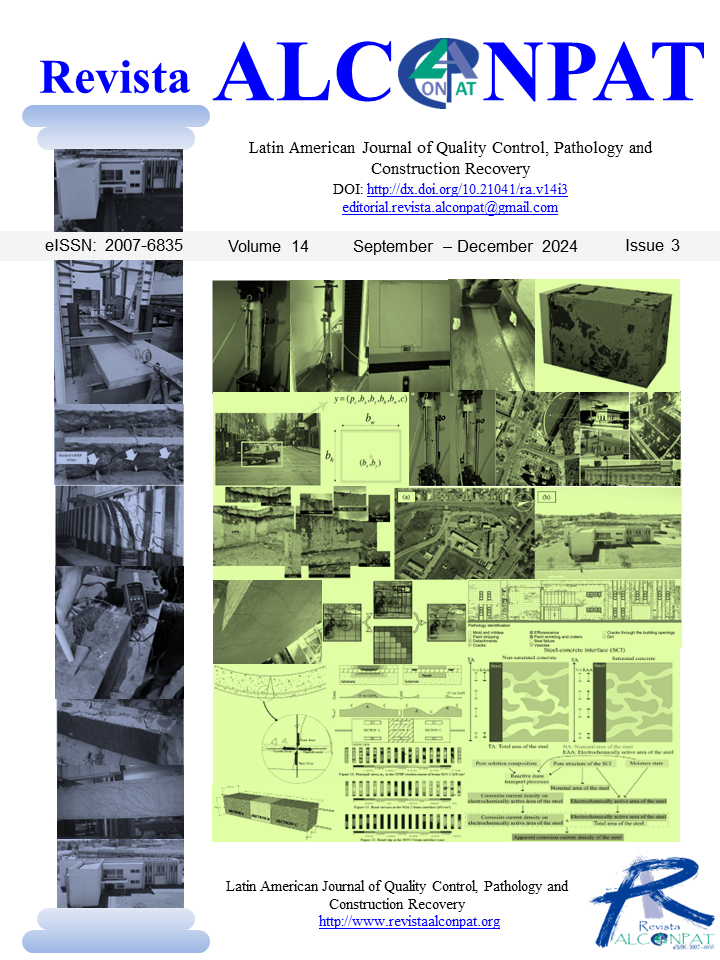Crack detection in buildings using the YOLO v8 network
DOI:
https://doi.org/10.21041/ra.v14i3.765Keywords:
pathological manifestations; building construction; crack detection; image analysis; YOLO v8Abstract
The objective of this study is to develop and apply deep neural networks for the automation of crack detection in buildings. The methodology involved training the YOLO v8 network with images collected from the internet, aiming to identify and locate cracks in real time. The model obtained 80% accuracy in validation with images not used in training, despite performance limitations in Google Collab. These limitations included restrictions on the execution environment, and the model is specific to cracks. The originality of the tool lies in its relevance for the automated detection of cracks, with the potential to extend to other pathological manifestations. It is concluded that the application of deep neural networks offers an efficient solution for the identification of problems in buildings.
Downloads
References
Barelli, F. (2018), “Introduction to Computer Vision: A practical approach with Python and OpenCV”. Code House.
Batistóti, J.O. (2023), “Remote sensing in the identification and characterization of crops of zootechnical interest”. Thesis (PhD) – Faculty of Veterinary Medicine and Animal Science, Federal University of Mato Grosso do Sul, Campo Grande – MS.
Bavaresco, L. (2023), “Instance segmentation for estimating fish length using artificial intelligence techniques”. Course completion work (graduation) - Federal University of Santa Maria, Technological Center, Computer Engineering Course, RS.
Bolina, F. L., Tutikian, B. F., Helena, P. (2019). “Structural pathology”. Text Workshop.
Caporrino, C. F. (2018). “Pathology in Freemasonry”. 2nd edition. São Paulo: Oficina de Textos.
Cha, Y.-J., Choi, W., Büyüköztürk, O. (2017). “Deep learning-based crack damage detection using convolutional neural networks”. Computer Aided Civil and Infrastructure Engineering, 32(5), p. 361–378.
De Souza, V. C. M., Ripper, T. (1998). “Pathology, recovery and reinforcement of concrete structures”. Pini.
Divvala, S., Redmon, J., Girshick, R., Farhadi, A. (2015). “You only look once: unified real-time object detection”. In Proceedings of the IEEE Conference on Computer Vision and Pattern Recognition.
Ekanayake, B. (2022). “A deep learning-based construction defect detection tool for sustainability monitoring”. In: 10th World Construction Symposium.
Hussain, M. (2023). “YOLO-v1 to YOLO-v8, the rise of YOLO and its complementary nature towards digital manufacturing and industrial defect detection”. Machines, vol. 11, no. 7, 2023. https://doi.org/10.3390/machines11070677
Kneipp, R. B. (2018). “The state of the art in the use of Drones for Naval and Offshore Inspection”. 81f. Dissertation - Federal University of Rio de Janeiro, Rio de Janeiro.
Kung, R.-Y., Pan, N.-H., Wang, C. C. N., Lee, P.-C. (2021). “Application of Deep Learning and Unmanned Aerial Vehicles in Building Maintenance”. Advances in Civil Engineering, Volume 2021, Issue 1, 5598690. https://doi.org/10.1155/2021/5598690
Mantripragada, M. (2020). “Digging deeper into YOLO V3 – A practical guide Part 1”. Available at: https://towardsdatascience.com/digging-deep-into-yolo-v3-a-hands-on-guide-part-1 - 78681f2c7e29
Redmon, J., Divvala, S., Girshick, R., Farhadi, A. (2016). “You Only Look Once: Unified Real-Time Object Detection”. 2016 IEEE Conference on Computer Vision and Pattern Recognition (CVPR), https://doi.org/10.1109/CVPR.2016.91
Ribeiro, D., Santos, R., Shibasaki, A., Montenegro, P., Carvalho, H., Calçada, R. (2020), Remote inspection of RC structures using unmanned aerial vehicles and heuristic image processing, Engineering Failure Analysis, Volume 117, 104813, ISSN 1350-6307, https://doi.org/10.1016/j.engfailanal.2020.104813
Swiezewski, J. (2020). “Yolo Algorithm and Yolo Object Detection: An Introduction”. Available at: <https://appsilon.com/object-detection-yolo-algorithm>.
Woo, H. J., Seo, D. M., Kim, M. S., Park, M. S., Hong, W. H., Baek, S. C. (2022). “Localization of cracks in concrete structures using an unmanned aerial vehicle”. Sensors, 22(17), 6711, https://doi.org/10.3390/s22176711
Yu, Z. (2022). “Deep learning approach based on YOLO V5s for crack detection in concrete”. In SHS Web of Conferences (Vol. 144, p. 03015). EDP Sciences.
Published
How to Cite
Issue
Section
License
_______________________________
License in effect from September 2020
You are free to:
- Share — copy and redistribute the material in any medium or format for any purpose, even commercially.
- Adapt — remix, transform, and build upon the material for any purpose, even commercially.
- The licensor cannot revoke these freedoms as long as you follow the license terms.
Under the following terms:
- Attribution — You must give appropriate credit , provide a link to the license, and indicate if changes were made . You may do so in any reasonable manner, but not in any way that suggests the licensor endorses you or your use.
- No additional restrictions — You may not apply legal terms or technological measures that legally restrict others from doing anything the license permits.
Notices:
You do not have to comply with the license for elements of the material in the public domain or where your use is permitted by an applicable exception or limitation .
No warranties are given. The license may not give you all of the permissions necessary for your intended use. For example, other rights such as publicity, privacy, or moral rights may limit how you use the material.





















.png)














